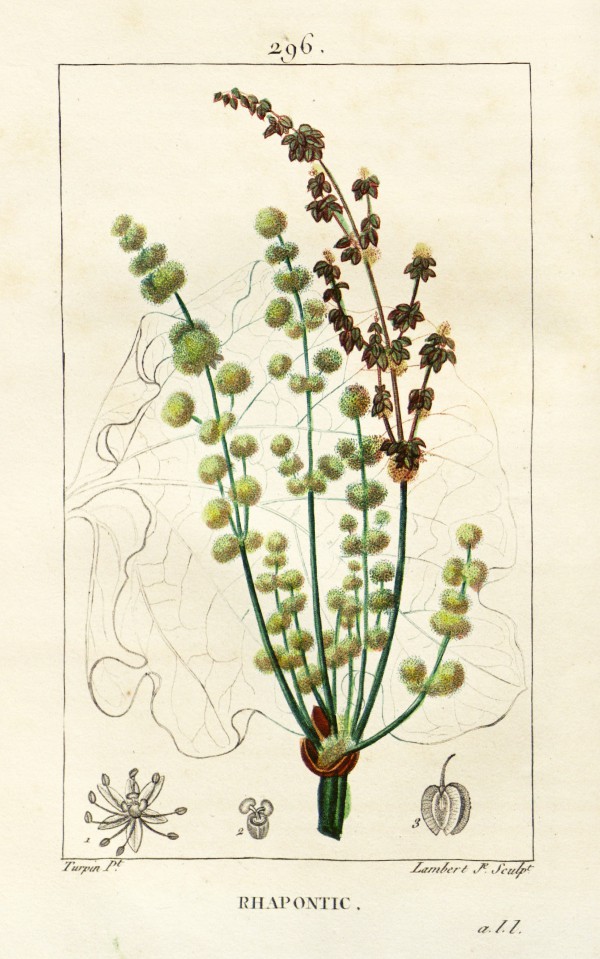Rheum rhaponticum L. - Polygonaceae - rhapontic rhubarb, false rhubarb , Rhapontik-Rhabarber, Sibirischer Rhabarber, Bulgarischer Rhabarber
Perennial herb, up to 1.5m high, native to Siberia, Norway, Bulgaria (probably naturalized from cultivation).
http://de.wikipedia.org/wiki/Rhapontik-Rhabarber
Analysis (HPLC) of a commercial sample of dried roots (Rhei rhapontici radix, Rhapontikwurzel) gave the stilbenoids rhaponticin (4.66%), desoxyrhaponticin (2.72%), dioxyrhaponticin (2.43%), rhapontigenin (0.67%) and desoxyrhapontigenin (0.22%).
[Über pflanzliche Stilbenderivate, 2. Mitt. 3, 5, 3′ 4′‐Tetrahydroxystilben‐3‐D‐glucosid, ein drittes Stilbenglykosid in Rhei rhapontici Radix., Gracza, L., Archiv der Pharmazie, Vol.317(4), 1984, 374-377]
[Hagers Handbuch der pharmazeutischen Praxis, Springer-Verlag, Berlin, 2010]
„The roots of R. rhaponticum were very rich in various hydroxystilbenes and contained four main substance groups –derivatives of trans-piceatannol, trans-resveratrol, trans-rhapontigenin and trans-deoxyrhapontigenin. Additionally, pterostilbene acetylglucosides and a number of hydroxyanthraquinones and their glycosides were identified in the root samples. The profile of polyphenols in the petioles of R. rhaponticum was similar to that of the roots but the content of individual substances was remarkably lower. The petioles of the R. rhaponticum additionally contained significant amounts of derivatives of flavonol quercetin, which is a good antioxidant.“
[Polyphenolic composition of roots and petioles of Rheum rhaponticum L., Püssa, T., Raudsepp, P., Kuzina, K., Raal, A., Phytochemical Analysis, 20(2), 2009, 98-103]
„Inhibition of oxidation of polyunsaturated fatty acids is proposed as a basis of the hepatoprotective effect of both trans-resveratrol and R. rhaponticum extract.“
[trans‐resveratrol alone and hydroxystilbenes of rhubarb (Rheum rhaponticum L.) root reduce liver damage induced by chronic ethanol administration: a comparative study in mice., Raal, A., Pokk, P., Arend, A., Aunapuu, M., Jõgi, J., Õkva, K., Püssa, T., Phytotherapy Research, Vol.23(4), 2009, 525-532]
„A dry extract from the roots of rhapontic rhubarb (extract Rheum rhaponticum (L.); ERr) has been commercially
available in Germany for over two decades to treat menopausal symptoms… consists mainly of rhaponticin (<90%) and aglycones (5%) of rhaponticin and desoxyrhaponticin. In plants, these natural hydroxystilbene compounds share a common biosynthetic pathway with resveratrol which is the first stilbene compound produced from p-coumaroyl-CoA catalysed by a selective stilbene synthesis. All other hydroxystilbenes in Rheum rhaponticum are derivatives of resveratrol… Neither clinical nor experimental studies observed adverse events of ERr, e.g., uterine and endometrial growth and proliferation. Moreover, ERr exerts SERM-like activities. For function ERb seems to be the more important ER which in turn has been proven to mediate e.g., anti-anxiety effects.“
[Treatment of menopausal symptoms by an extract from the roots of rhapontic rhubarb: the role of estrogen receptors., Vollmer, G., Papke, A., Zierau, O., Chin Med, 5(7), 2010, 7]
http://www.biomedcentral.com/content/pdf/1749-8546-5-7.pdf
„Activation of ERβ with rhubarb might be the reason that the extract does not show proliferative effects in uterine tissue and its antiestrogenic effects could be related to its partial agonistic effects for ERs which manifests as antagonistic activity when the full agonist, estradiol, is present. In summary, rhubarb is mainly an ERβ activating plant, although its reported active compounds, lindleyin, rhapontigenin, and desoxyrhapontigenin, are not ERβ-selective.“
[Botanical modulation of menopausal symptoms: mechanisms of action?, Hajirahimkhan, A., Dietz, B.M., Bolton, J.L., Planta medica, 79(7), 538, 2013]
http://www.ncbi.nlm.nih.gov/pmc/articles/PMC3800090/

Chaumeton, F.P., Flore médicale, vol.6 t.296 (1832)
http://plantillustrations.org/species.php?id_species=874418
